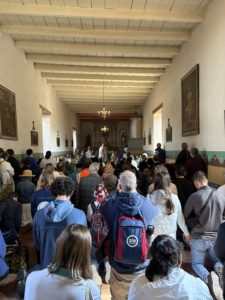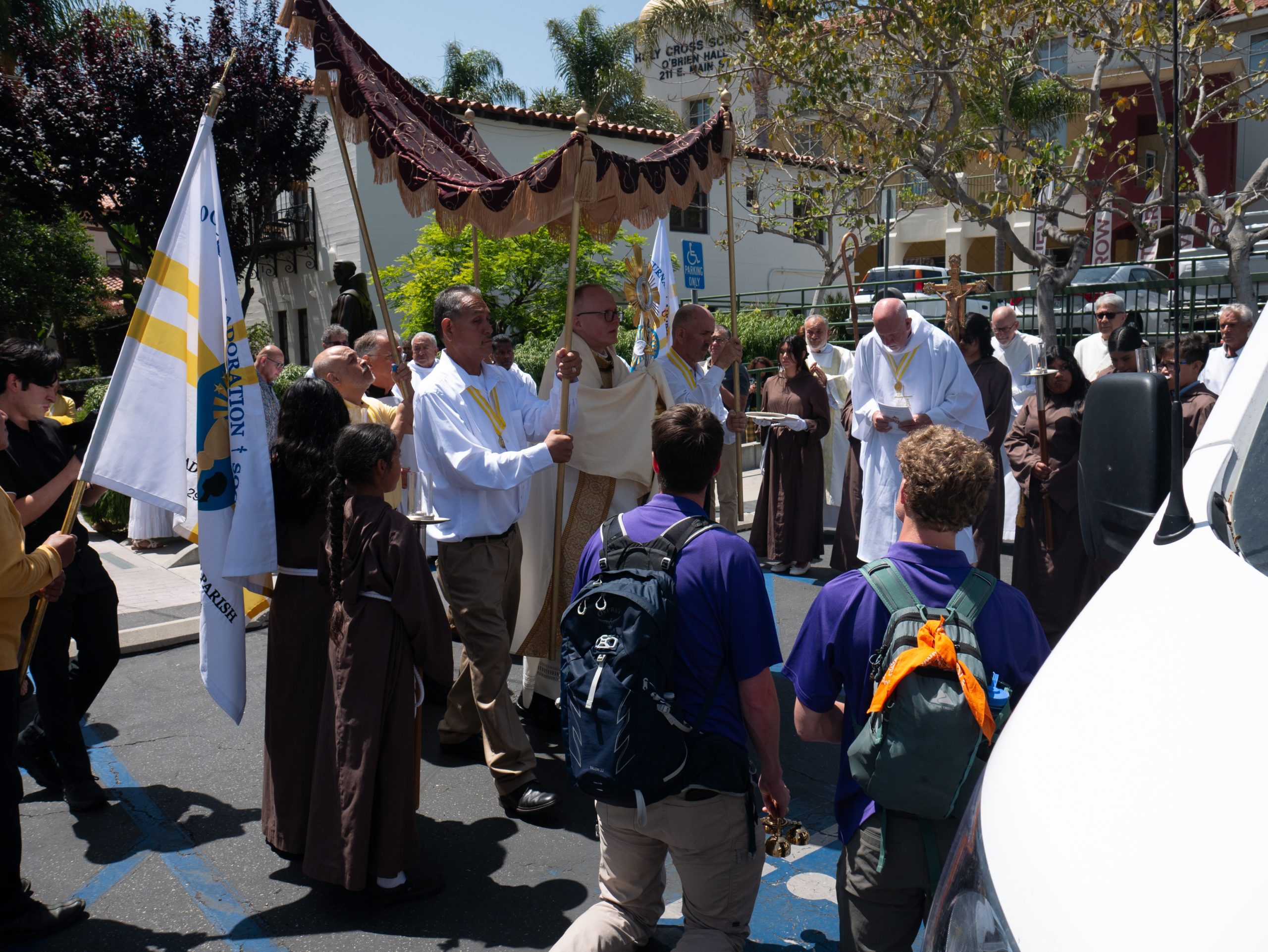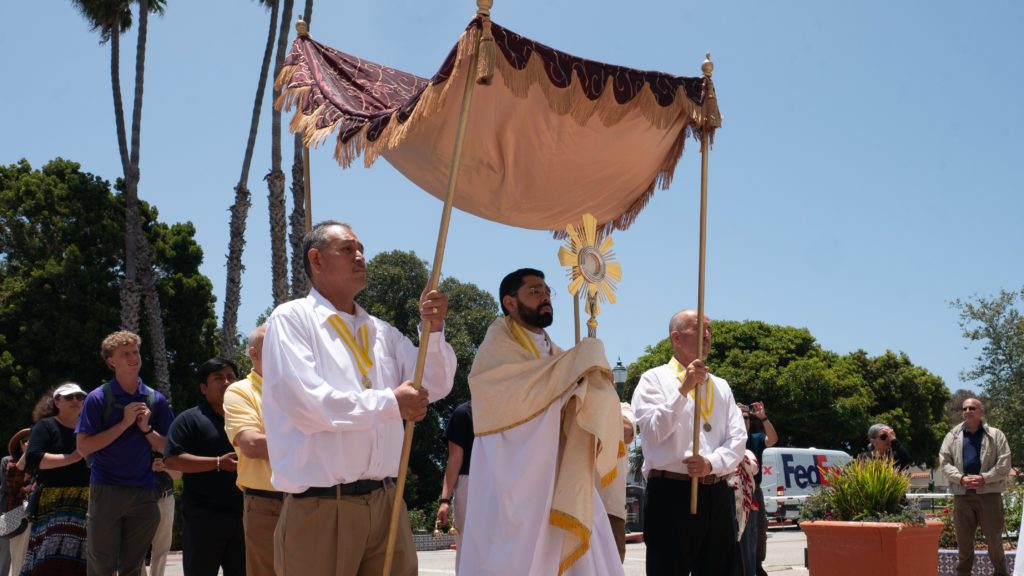Before visiting the fire-stricken communities of Altadena and Pacific Palisades, the National Eucharistic Pilgrimage made something of a detour while in Southern California during its final weekend.
After leaving Orange County early on the morning of June 20, the white pilgrimage van carrying a monstrance with the Blessed Sacrament and some of the “perpetual pilgrims” made the long drive past its final destination, Los Angeles, and up to the seaside town of Ventura for a 1 p.m. Mass at Mission Basilica San Buenaventura.
On such a busy weekend, why Ventura?
“There’s something about taking Jesus to all the parts of the archdiocese,” said Virginia native Frances Webber, one of the pilgrimage’s eight “perpetual pilgrims.”

Webber could speak from experience. For the last five weeks, she and her companions clocked more than 3,000 miles, zigzagging through 40 Catholic dioceses in 10 states, accompanying the Blessed Sacrament from Indiana to California. With so many stops to make and people to reach through Masses, works of mercy, and processions, their route didn’t follow anything resembling a straight line.
“Ventura is far enough that many of the people there probably won’t come down on Sunday,” said Webber, referring to the concluding June 22 Mass at the Cathedral of Our Lady of the Angels. “So why not take Jesus to them?”
When the van pulled into the San Buenaventura parking lot, the pilgrims and monstrance were welcomed by a delegation from the Knights of Columbus, together with regional Auxiliary Bishop Sławomir Szkredka, San Buenaventura pastor Father Tom Elewaut, and several other priests and deacons.
From there, a short procession brought the Blessed Sacrament into the mission, founded in 1782 by St. Junípero Serra and declared a basilica in July 2020 by Pope Francis.
Inside, Szkredka took the opportunity during his homily to thank the pilgrims, saying “you have given all of us a beautiful illustration of what it means to walk through life with our Eucharistic Lord.”
“Yes, we carry him. But in reality, he carries us,” he said.
Szkredka compared the pilgrimage to the story of Elijah in the Mass’s first reading, in which the prophet is miraculously given food and water after a tiring journey through the desert, and then fed again before starting a longer journey.
In the same way, Szkredka said, the Eucharist serves to refresh a person spiritually after a long day, other times, to strengthen them before a long journey or challenge.
“The Lord knows that on our life journey we need to be refreshed, and we need to be strengthened,” said the bishop.

Among those at the Mass was psychotherapist and counselor Greg Wood, who helped create the Camino de California, an independent pilgrimage effort that began in early June and merged with the National Eucharistic Pilgrimage in San Diego.
Traveling southward from Northern California, the pilgrimage visited all of California’s 21 Spanish missions, driving between them while stopping for Mass and Eucharistic adoration, walking processions, and opportunities to perform “corporal and spiritual works of mercy” along the way.
One of the pilgrimage’s biggest successes was in San Jose, where more than 2,000 people joined a five-mile Eucharistic procession through the city’s streets.
“People in California need Jesus, and this pilgrimage has been a way of resanctifying the route between the 21 missions,” said Wood.
But Wood’s favorite moment came on the trip’s first day at Sonoma County’s Mission San Francisco Solano, which had not hosted public worship since becoming part of the California Park System in 1906.
“It was literally the first time in 125 years that Jesus had been in the Solano Mission,” said Wood, also the founder of the annual summer St. Junípero Serra Walking Pilgrimage.

As 200 pilgrims processed from a nearby Catholic parish to the mission, they passed a park where Catholic schoolchildren were spending their final day of the school year. Wood said that “every single child and teacher” got down to kneel as the Blessed Sacrament passed.
“Most of us were just in tears seeing that witness.”
While most of the Camino pilgrims had remained in San Diego or Los Angeles that Friday, Ventura resident “Susan” decided to return home and attend the San Buenaventura Mass.
After missing last summer’s Eucharistic Congress in Indianapolis, Susan said she and a friend “knew in our hearts that we had to be a part of this,” so they drove to Northern California to join the pilgrims. She found the Camino de California experience to “be very fulfilling, very spiritual, and very well-organized.”

“It's just about standing up and speaking out and being present to let others know that Our Lord is alive,” said Susan, who spent the pilgrimage praying for family members who’d stopped practicing the Catholic faith, while also embracing the chance to give a public witness of her faith during stops along the route.
By the end, she said she’d heard Christ’s personal message to her loud and clear.
“It’s been kind of an affirmation of God saying to me, ‘Daughter, I’m here. I know your journey. I know you want to be led by me, keep on. Keep at it.’ ”

